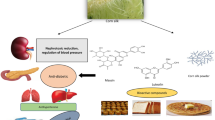Abstract
Scopoletin has been isolated and identified in gari, a cassava food consumed in Nigeria (West Africa). Its levels in gari and cassava flour is not altered by post processing treatments such as sundrying, refrigeration and storage. Scopoletin has also been identified as an active principle in the traditional herbal infusion of the fruit ofTetrapleura tetraptera TAUB used in the ethnopharmacology of West Africa. It is a potent hypotensive and non-specific spasmolytic agent. These pharmacological effects of Scopoletin are probably the underlying factors in the slowly developing tropical neuropathy characterised by optic atrophy, nerve deafness and ataxia endemic among populations subsisting on cassava diets such as gari. Hitherto, these toxicities were attributed to cyanogenic glucosides (cyanide) present in cassava.
Similar content being viewed by others
References
Nartey F (1966) Aflatoxins ofAspergillus flavus grown on cassava. Physiol Plant 19: 818–822
Purchio A (1972) Search for AFB1 and similar fluorescent compounds in Brazillian Cassava flour. Rev Microbiol 3(3): 121–125
Nagarjan V, Tulpule PG, Bhat RV (1973) Aflatoxin-like factors in Tapioca (Manihot utillissima). Environ Physiol Biochem 3(1): 13–18
Rickard JE (1981) Study of the production of xylem occlusions and Scopoletin in cassava roots in response to injury. R Microsc Sco Proc 16: 249
Uritani I, Data ES, Tanaka Y (1982) In: Bioresources investigation on production, storage, processing and vegetation of root crops in the tropics. Uritani I, and Reye ED (ed), Nagoya University Co-op; Nagoya, pp. 32
Flores DM, Garcia VV, Uritani I (1983) The relationship between methods of making cassava flour and coumarin formation during drying. J Jpn Soc Food Sci Tech 30(3): 175–177
Obidoa O, Lekwuwa O (1985) Research Notes
Rickard JE (1985) Physiological deterioration of cassava roots. J Sci Food Agric 36: 167–176
Sakai T, Nakagawa Y, Uritani I, Data ES (1986) Occurence of various kinds of metabolites in physiological and microbially damaged cassava (Manihot esculenta Crantz). Agric Biol Chem 50:(11) 2905–2907
Tanaka Y, Data ES, Lape VG, Villegas CD, Gorgonio M, Hirosed S, Uritani I (1984) Effect of pruning treatment on physiological deterioration in cassava roots. Agric Biol Chem 48(3): 739–743
Obidoa I, Obasi S (1989) Laboratory investigations on fluorescent compounds in Nigerian staple diets. Unpublished data
Uritani I, Data ES, Villegas RJ, Flores RJ Hirose S (1983) Relationship between secondary metabolism changes in cassava roots tissue and physiological deterioration. Agric Biol Chem 47(7): 1591–1598
Garcia VV, Lapitan OB, Flores DM, Uritani I (1984) Changes in coumarin and phenol content and peroxidase activity as affected by drying methods for cassava root slices and their relation to food quality. Trop. Root Crops: Post harvest physiology and processing 7: 299–309
Wheatley CC (1982) Studies on cassava root post-harvest physiological deterioration. Ph.D Thesis, University of London, 246 pp
Rickard JE, Coursey DG (1981) Cassava storage. Part I: storage of fresh cassava roots. Trop Sci, 23: 1–32
Obasi SC (1990) In comparative effects of scopoletin and AFB on Bovine R.B.C. and hepatic mitochondrial respiration. Ph.D Thesis, University of Nigeria, Nsukka.
Taniguchi T, Data ES (1982) In: Uritani I, Reyes ED (ed), Bio-Resources investigation on production. Storage, processing and vegetation of root crops in the tropics (1981 — Interim report) Nagaoya University co-operation. Nagoya pp. 22–31
Lockwood RB (1969) Poisonous food for millions. Pacific Discovery 22(3): 28–31
Dorozynski A (1978) Cassava may lead to mental retardation Nature 272: 121
Herbert VC (1988) In modern nutrition in health and disease, 7th Edition. ME Shils, UR Young (eds), Lea and Febiger, 471
Way JL (1984) Cyanide intoxication and its mechanism of antogonism. Ann Rev Pharmacol Toxicol 24: 451–481
Money GL (1958) Endemic neuropathies in the Epe district of southern Nigeria. West Afr Med J. 7: 58–62
Osuntokun BO, Durowoju JE, McFarlene H, Wilson J (1968) Plasma amino acids in the Nigerian nutritional ataxic neuropathy. Br Med J 3: 47–649
Ononogbu IC, Emole I (1978) The effects of gari on rat plasma cholesterol. Artherosclerosis 31: 101–104
Coursey DG, Haynes PN (1970), World crops July/Aug. 261–265
Onyeneke EC (1984) Effects of gari diet on plasma phospholipids. Nutrition Reports International 29(4): 775–781
Chilaka FC, Anosike EO, Obidoa O (1985) Effects of high and prolonged gari diets on some microsomal enzyme activities of rat liver, Plant Fd Hum Nutr 35(2): 159–164
Obidoa O, Ngodo VOS (1984) Effect of prolonged consumption of gari (cassava,Manihot Utillisima) on rat hepatic energy metabolism. Plant Fd Hum Nutr 34: 159–168
Ezeala DO, Okoro N (1986) Processing techniques and hydrocyanic acid content of Casava-based human food stuff in Nigeria. J Fd Biochem 10(2): 125–132
Adesina SK, Ojewole JA, Marquis VO (1981) Afric J Med Plants 4: 27, cited in ref. 33 Cardiovascular and neuromuscular actions of Scopoletin from the fruit ofTetrapleura tetraptera. Plant Med. 49: 99–102
Dalziel JM (1985) In: The useful plants of West Tropical Africa. London Crown Agents for Overseas Governments and administation cited in ref. 33 Cardiovascular and neuromuscular actions of Scopoletin from the fruit ofTetrapleura tetraptera. Plant Med 49: 99–102
Elewude JI (1978) Communication cited in ref. 33
Ojewole JAO, Adesina SK (1983a) Cardiovascular and neuromuscular actions of Scopoletin from the fruit ofTetrapleura tetraptera. Plant Med. 49: 99–102
Ojewole JAO, Adesina SK (1981) Cited in ref 35.
Ojewole JAO, Adesina SK (1983b) Mechanism of the Hypotensive effect of Scopoletin isolated from the fruit ofTetrapleura tetraptera. Plant Med 49: 46–50
Obasi SC, Obidoa O (1989) Coumarin compounds in cassava, yam, cocoyam and maize: 1. Preliminary studies on blood coagulation and binding to erythrocyte, and hemoglobin. In: Book of abstracts of the 14th annual conference of the Biochemical Society of Nigeria pp. 11
Author information
Authors and Affiliations
Rights and permissions
About this article
Cite this article
Obidoa, O., Obasi, S.C. Coumarin compounds in cassava diets: 2 health implications of scopoletin in gari. Plant Food Hum Nutr 41, 283–289 (1991). https://doi.org/10.1007/BF02196398
Received:
Accepted:
Issue Date:
DOI: https://doi.org/10.1007/BF02196398




